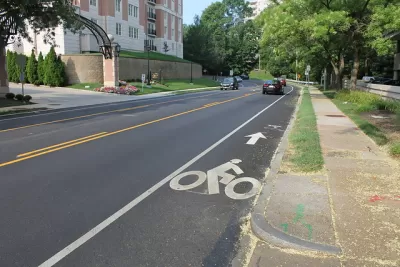The new form-based zoning code under consideration in the affluent Philadelphia suburb of Lower Merion "has something to teach Philadelphia and other big cities about how to organize density smartly," according to Inga Saffron.

Inga Saffron writes of the new zoning code in the Philadelphia suburb of Lower Merion as an example of the "conflicted soul of the suburbs"—that is, the conflict between a contemporary push for more inclusionary land use regulations with the status quo of politics ruled by residential property owners.
Lower Merion's new zoning code will face a final vote by the Board of Commissioners on September 18. "The rules," writes Saffron, "enshrine some of the most cherished — and exclusionary — features of 1950s suburbia. Big lots. Big houses. Big requirements for off-street parking. Affordable housing and sustainable construction barely rate a mention."
That seems like a full expression of the suburban status quo, but there is one visible sign of reform more in keeping with more recent planning trends: "Lower Merion is also going further than most of its peers to create pockets of density near transit and encourage walkability throughout the township," according to Saffron. Accessory Dwelling Units will also be legalized by the new code. Saffron notes that Philadelphia has only just begun to tackle that issue.
Lower Merio hired Elizabeth Plater-Zyberk, co-founder of the Congress for New Urbanism and Lower Merion native, to write the new zoning code. It follows, then, that Lower Merion's new code is of the form-based variety. Saffron explains:
Because Lower Merion was built around the Pennsylvania Railroad’s “Main Line,” it has always been a unique urban-suburban hybrid, with dense, transit-oriented villages like Ardmore and Bryn Mawr, and rolling country estates farther out in Gladwyne and Penn Valley that are totally car-dependent. The form-based code treats the two halves as different places, preserving the storybook version of the Main Line while still allowing density near the train stations.
The article includes insight from Plater-Zyberk about the city and the new code.
FULL STORY: Lower Merion’s new zoning code is a love letter to suburbia | Inga Saffron

Alabama: Trump Terminates Settlements for Black Communities Harmed By Raw Sewage
Trump deemed the landmark civil rights agreement “illegal DEI and environmental justice policy.”

Planetizen Federal Action Tracker
A weekly monitor of how Trump’s orders and actions are impacting planners and planning in America.

Why Should We Subsidize Public Transportation?
Many public transit agencies face financial stress due to rising costs, declining fare revenue, and declining subsidies. Transit advocates must provide a strong business case for increasing public transit funding.

Understanding Road Diets
An explainer from Momentum highlights the advantages of reducing vehicle lanes in favor of more bike, transit, and pedestrian infrastructure.

New California Law Regulates Warehouse Pollution
A new law tightens building and emissions regulations for large distribution warehouses to mitigate air pollution and traffic in surrounding communities.

Phoenix Announces Opening Date for Light Rail Extension
The South Central extension will connect South Phoenix to downtown and other major hubs starting on June 7.
Urban Design for Planners 1: Software Tools
This six-course series explores essential urban design concepts using open source software and equips planners with the tools they need to participate fully in the urban design process.
Planning for Universal Design
Learn the tools for implementing Universal Design in planning regulations.
Caltrans
Smith Gee Studio
Institute for Housing and Urban Development Studies (IHS)
City of Grandview
Harvard GSD Executive Education
Toledo-Lucas County Plan Commissions
Salt Lake City
NYU Wagner Graduate School of Public Service





























